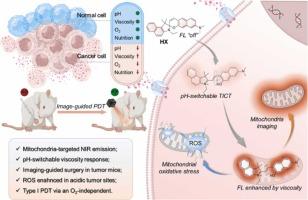A mitochondria-targeted NIR fluorescent probe with pH-switchable viscosity response and photodynamic therapy via an O2‑independent photocatalyst
IF 3.7
1区 化学
Q1 CHEMISTRY, ANALYTICAL
引用次数: 0
Abstract
The tumor microenvironment in solid tumor is usually featured by low pH, high viscosity, and hypoxia etc. Real-time monitoring and efficient suppression of tumor tissues based on the characteristic parameters of the tumor site holds significant importance. Herein, we design a mitochondria-targeted NIR fluorescent probe named HX by incorporating naphthalene moiety with hemicyanine dyes. Under acidic conditions in tumor site, the neutral probe HX can be protonated with the pyranoid ring opening, thereby activating the donor-π-acceptor (D-π-A) framework and enhancing its sensitivity to changes in viscosity. In addition, the positive charge of the hemicyanine structure promotes the probe to enter into the mitochondria. Thus, HX has the ability of pH-switch to target mitochondria and detect the viscosity of the tumor acidic microenvironment. Furthermore, we also demonstrate that it can be served as photosensitizer with Type Ⅰ reaction for photodynamic therapy (PDT) in mitochondria. By using simulated tumor mice, we finally demonstrate that HX can distinguish tumor tissues from normal tissues in intraoperative navigation and monitor wound infection, as well as enhanced tumor inhibition with low concentration O2.

一种线粒体靶向近红外荧光探针,具有ph可切换的粘度响应和通过不依赖O2的光催化剂进行光动力治疗
实体瘤的肿瘤微环境通常具有低pH、高粘度、低氧等特点。基于肿瘤部位的特征参数对肿瘤组织进行实时监测和有效抑制具有重要意义。在此,我们设计了一种线粒体靶向近红外荧光探针HX,将萘部分与半花青素染料结合。在肿瘤部位的酸性条件下,中性探针HX可以随着类吡啶环的打开而质子化,从而激活供体-π-受体(D-π-A)框架,增强其对粘度变化的敏感性。此外,半花青素结构的正电荷促进探针进入线粒体。因此,HX具有ph开关靶向线粒体,检测肿瘤酸性微环境粘度的能力。此外,我们还证明它可以作为具有Ⅰ型反应的光敏剂用于线粒体的光动力治疗(PDT)。通过模拟肿瘤小鼠,我们最终证明HX在术中导航、监测创面感染时能够区分肿瘤组织和正常组织,并在低浓度O2下增强肿瘤抑制作用。
本文章由计算机程序翻译,如有差异,请以英文原文为准。
求助全文
约1分钟内获得全文
求助全文
来源期刊

Sensors and Actuators B: Chemical
工程技术-电化学
CiteScore
14.60
自引率
11.90%
发文量
1776
审稿时长
3.2 months
期刊介绍:
Sensors & Actuators, B: Chemical is an international journal focused on the research and development of chemical transducers. It covers chemical sensors and biosensors, chemical actuators, and analytical microsystems. The journal is interdisciplinary, aiming to publish original works showcasing substantial advancements beyond the current state of the art in these fields, with practical applicability to solving meaningful analytical problems. Review articles are accepted by invitation from an Editor of the journal.
 求助内容:
求助内容: 应助结果提醒方式:
应助结果提醒方式:


